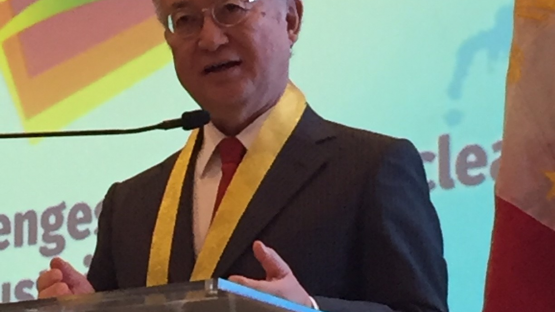(As prepared for delivery)
Thank you, Mr Chairman.
Good morning, Ladies and Gentlemen.
I am delighted to see so many young people taking part in the Philippine Nuclear Youth Summit. This is an excellent initiative by the Philippine Nuclear Research Institute.
This is my third visit to your country since I became Director General of the International Atomic Energy Agency in 2009, and my second this year.
When I was last here, in January, I had a chance to visit two schools – the Q.C. Science High School and San Francisco High School. The students were extremely clever and I was very impressed by their energy and enthusiasm.
Imagination and enthusiasm are vitally important in the nuclear field – along with a high degree of technical competence, of course. The fact that you are here today suggests you have some idea of what exciting career possibilities are available in nuclear science and technology.
I grew up in Japan after World War Two. My country has limited natural resources. But by making good use of all that modern technology has to offer, and investing in education, Japan built up one of the most modern and successful economies in the world.
So I am a great believer in science and technology.
At the IAEA, an important part of our work is to make nuclear science and technology available to developing countries.
This enables countries to generate the electricity that is vital for economic growth and to do it safely and securely. It helps to save the lives of cancer patients. It helps countries such as yours to increase food production by using radiation to develop new varieties of rice. It enables countries to manage their supplies of water effectively.
Some applications of nuclear technology might surprise you.
There was a dreadful earthquake in Nepal in April – something which your country is all too familiar with. The IAEA helped the authorities to determine whether damaged buildings such as hospitals and schools were safe, using non-destructive testing techniques, including radiography.
Some countries in West Africa have been plagued by recurring outbreaks of the deadly Ebola Virus Disease. We provided equipment and diagnostic kits, using nuclear-derived techniques, which made it possible to identify the virus much more rapidly.
All of this makes a real difference to people’s lives. I visit 20 to 30 countries every year. Seeing the impact of the IAEA’s work makes me very proud.
Ladies and Gentlemen,
The Philippines has been a very active Member State of the IAEA since 1958, the year after the Agency was established.
Many of your fellow countrymen and women have served on our staff. Many researchers have spent time at our nuclear applications laboratories near Vienna, or held fellowships at the IAEA.
More than 300 Philippine nationals have worked as international experts under the IAEA technical cooperation programme, sharing their knowledge and experience with other developing countries.
In September every year, government ministers and senior officials and scientists from our 167 Member States meet in Vienna for the IAEA General Conference.
This year, the Conference included the first ever event to focus exclusively on young people, called the Nuclear Olympiad, which we hosted together with the World Nuclear University.
High school and university students were invited to submit videos on nuclear-related issues. A bright young physicist from the Philippines, Mr Anton Philippe Tanquintic, won second prize. I understand he will be speaking to you later.
Ladies and Gentlemen,
I hope that many of you will be inspired by today’s Philippine Nuclear Youth Summit to pursue careers in the nuclear field.
If you do, you will see some very exciting technological innovations during your careers – for example new generations of nuclear power reactors which will be safer and generate less waste, and exciting new forms of medical imaging that will improve cancer diagnosis and treatment.
You may be responsible for some of those innovations yourself.
Perhaps some of you will even come to work for the IAEA. It is an exciting place to work.
My message to you today is that nuclear science and technology is a very cool field to be in. You will find it personally very rewarding and you will have an opportunity to contribute to the well-being and prosperity of your own country, and of the whole world.
Thank you.


